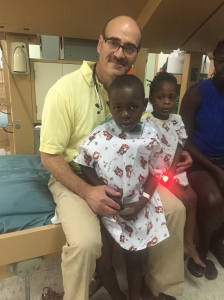Time again to talk flu shots. I can keep this pretty brief. Flu season is from October-April. Most of us know the sgns and symptoms of influenza: high fever, nausea and vomiting, body aches progressing to congestion and cough and (usually) resolution in under 1 week. Complications such as dehydration and pneumonia are not uncommon. A hallmark of influenza infection, I find, is its abrupt onset. I compare it to stepping through a doorway: first you feel well and then suddenly within a few moments–under an hour, usually–you feel feverish and awful.
Influenza is a major public health problem. Before dismissing that as relatively unimportant compared to considering your child’s needs(let alone that the flu shot is good for them) too quickly I encourage you to stop and think about parents, grandparents, and other senior loved ones in your world. Recall that immunizing the children protects those folks as well, as previously documented.
I currently stock quadrivalent flu vaccines for 6-35 months and > 3 years. “Quadrivalent” means that it covers the 3 traditional strains of flu plus the aggressive H1N1 strain. All are single dose vials so they are free of mercury or any preservatives. These are “inactivated” or “killed” so they are milder and completely incapable of causing infection themselves. I also have a small supply of “flumist” vaccine administered via nasal spray. It is also quadrivalent and preservative free. This version is “live, attenuated” which means it’s nominally stronger but with slightly greater incidence of side effects and has the rare potential to cause the flu itself. It should not be given to immunocompromised individuals or those on aspirin therapy.
Optimally almost all healthy people > 6 months old should receive a flu shot with special emphasis for people in categories as noted here. New Jersey state law requires all children attending day care and nursery schools to get flu shots. Less than 9 year old children need a booster one month after the initial dose the first year that they are immunized.
Please contact me for questions or comments and thanks for following.






